Abstract
Knowledge of the immune response to rotavirus is crucial for vaccine development. We compared an epitope-blocking assay (EBA) that uses VP7-specific monoclonal antibodies with neutralization assays (NAs) with polyclonal antisera for detecting serum antibody responses after natural rotavirus infection in children. Twenty-six serum pairs from children living in an orphanage with and without symptoms during two rotavirus outbreaks were evaluated for VP7 type 1-, 2-, 3-, and 4-specific antibody responses. In the first outbreak, which was caused by a VP7 type 3 strain, homotypic antibody responses were detected in 11 of 11 symptomatic children by NA and in 10 of 11 symptomatic children by EBA. Heterotypic antibody responses were detected more frequently (12 of 15 children) by NA than by EBA, and the heterotypic epitope-blocking antibody responses occurred in children older than 14 months of age. Antibody responses in asymptomatic children were more commonly detected by EBA than by NA. EBA results from the sera of children in the second outbreak indicated that it was caused by VP7 type 4, whereas NA results suggested it was caused by VP7 type 3. Our results confirm that EBA is a sensitive and specific method for determining VP7 type-specific immune responses after natural rotavirus infections.
Full text
PDF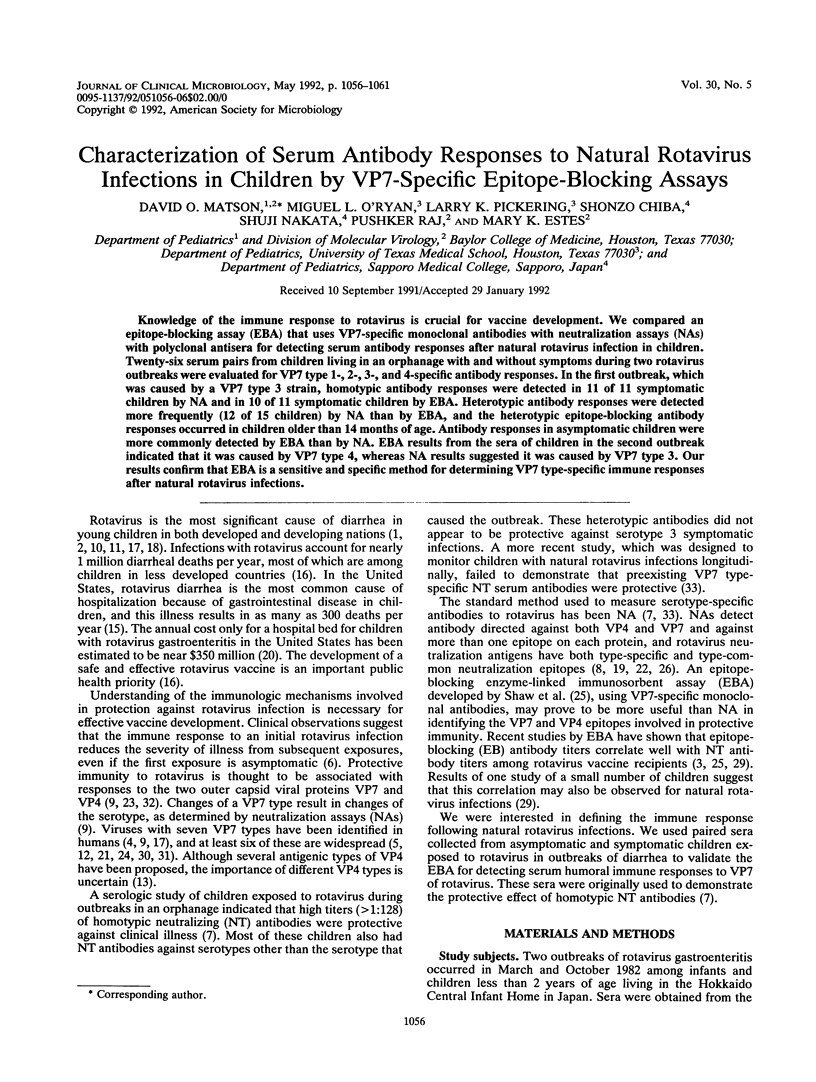
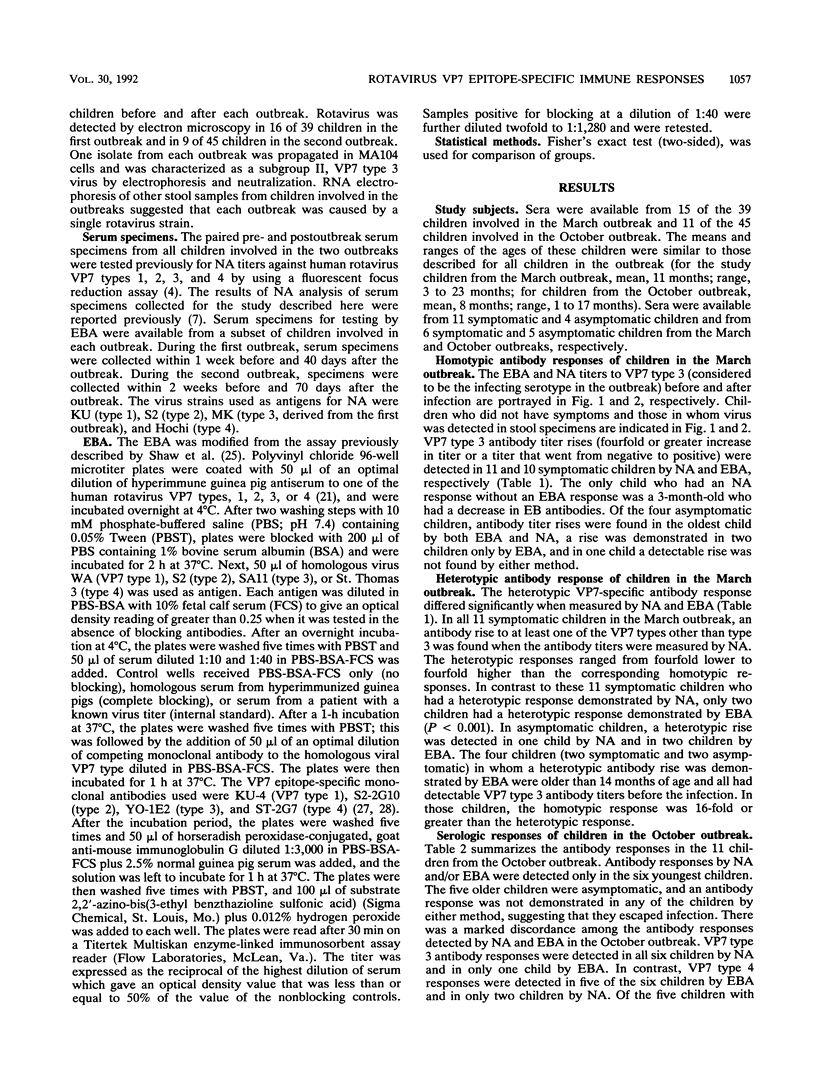
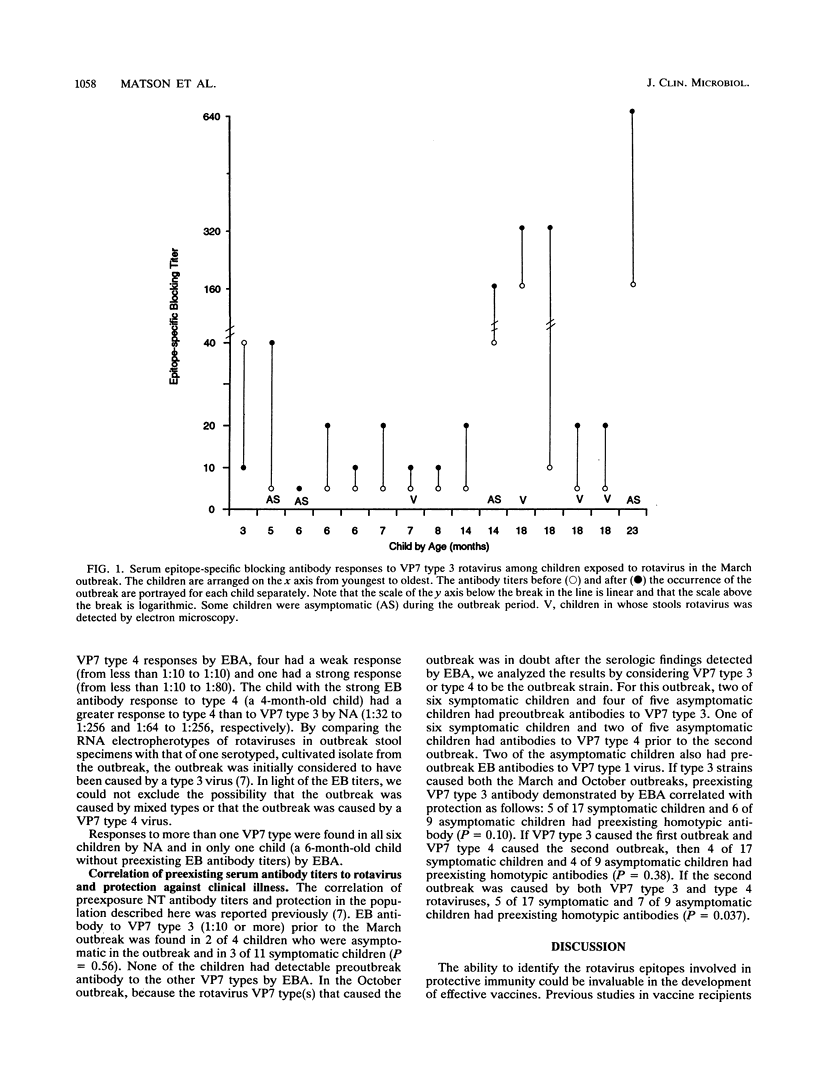
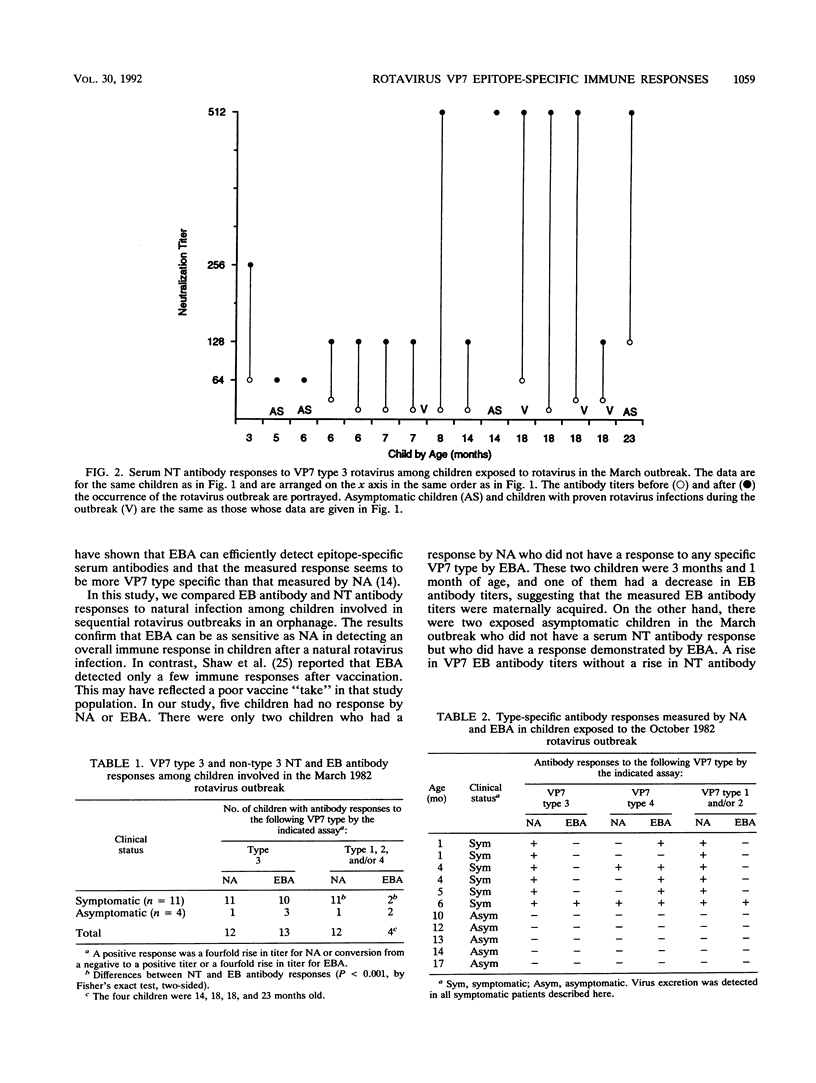
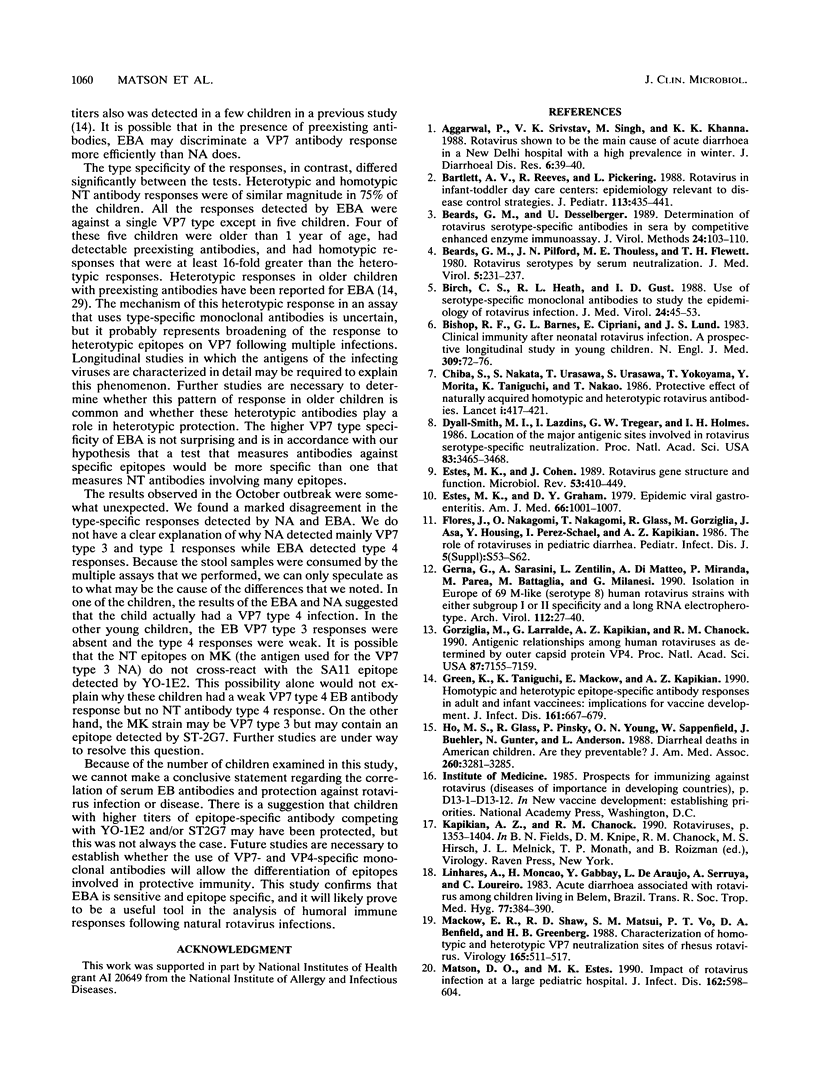
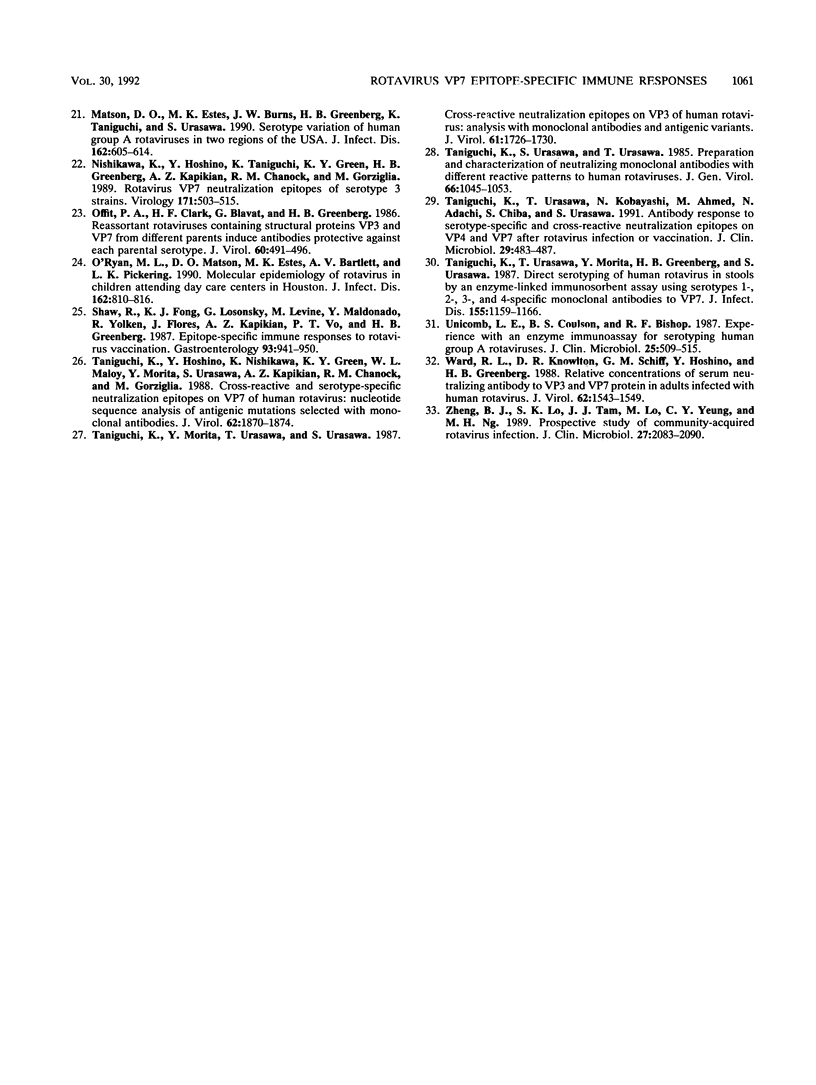
Selected References
These references are in PubMed. This may not be the complete list of references from this article.
- Aggarwal P., Srivastav V. K., Singh M., Khanna K. K. Rotavirus shown to be the main cause of acute childhood diarrhoea in a New Delhi hospital with a high prevalence in winter. J Diarrhoeal Dis Res. 1988 Mar;6(1):39–40. [PubMed] [Google Scholar]
- Bartlett A. V., 3rd, Reves R. R., Pickering L. K. Rotavirus in infant-toddler day care centers: epidemiology relevant to disease control strategies. J Pediatr. 1988 Sep;113(3):435–441. doi: 10.1016/S0022-3476(88)80624-3. [DOI] [PMC free article] [PubMed] [Google Scholar]
- Beards G. M., Desselberger U. Determination of rotavirus serotype-specific antibodies in sera by competitive enhanced enzyme immunoassay. J Virol Methods. 1989 Apr-May;24(1-2):103–110. doi: 10.1016/0166-0934(89)90012-8. [DOI] [PubMed] [Google Scholar]
- Beards G. M., Pilfold J. N., Thouless M. E., Flewett T. H. Rotavirus serotypes by serum neutralisation. J Med Virol. 1980;5(3):231–237. doi: 10.1002/jmv.1890050307. [DOI] [PubMed] [Google Scholar]
- Birch C. J., Heath R. L., Gust I. D. Use of serotype-specific monoclonal antibodies to study the epidemiology of rotavirus infection. J Med Virol. 1988 Jan;24(1):45–53. doi: 10.1002/jmv.1890240107. [DOI] [PubMed] [Google Scholar]
- Bishop R. F., Barnes G. L., Cipriani E., Lund J. S. Clinical immunity after neonatal rotavirus infection. A prospective longitudinal study in young children. N Engl J Med. 1983 Jul 14;309(2):72–76. doi: 10.1056/NEJM198307143090203. [DOI] [PubMed] [Google Scholar]
- Chiba S., Yokoyama T., Nakata S., Morita Y., Urasawa T., Taniguchi K., Urasawa S., Nakao T. Protective effect of naturally acquired homotypic and heterotypic rotavirus antibodies. Lancet. 1986 Aug 23;2(8504):417–421. doi: 10.1016/s0140-6736(86)92133-1. [DOI] [PubMed] [Google Scholar]
- Coulson B. S., Unicomb L. E., Pitson G. A., Bishop R. F. Simple and specific enzyme immunoassay using monoclonal antibodies for serotyping human rotaviruses. J Clin Microbiol. 1987 Mar;25(3):509–515. doi: 10.1128/jcm.25.3.509-515.1987. [DOI] [PMC free article] [PubMed] [Google Scholar]
- Dyall-Smith M. L., Lazdins I., Tregear G. W., Holmes I. H. Location of the major antigenic sites involved in rotavirus serotype-specific neutralization. Proc Natl Acad Sci U S A. 1986 May;83(10):3465–3468. doi: 10.1073/pnas.83.10.3465. [DOI] [PMC free article] [PubMed] [Google Scholar]
- Estes M. K., Cohen J. Rotavirus gene structure and function. Microbiol Rev. 1989 Dec;53(4):410–449. doi: 10.1128/mr.53.4.410-449.1989. [DOI] [PMC free article] [PubMed] [Google Scholar]
- Estes M. K., Graham D. Y. Epidemic viral gastroenteritis. Am J Med. 1979 Jun;66(6):1001–1007. doi: 10.1016/0002-9343(79)90457-1. [DOI] [PMC free article] [PubMed] [Google Scholar]
- Flores J., Nakagomi O., Nakagomi T., Glass R., Gorziglia M., Askaa J., Hoshino Y., Perez-Schael I., Kapikian A. Z. The role of rotaviruses in pediatric diarrhea. Pediatr Infect Dis. 1986 Jan-Feb;5(1 Suppl):S53–S62. doi: 10.1097/00006454-198601001-00011. [DOI] [PubMed] [Google Scholar]
- Gerna G., Sarasini A., Zentilin L., Di Matteo A., Miranda P., Parea M., Battaglia M., Milanesi G. Isolation in Europe of 69 M-like (serotype 8) human rotavirus strains with either subgroup I or II specificity and a long RNA electropherotype. Arch Virol. 1990;112(1-2):27–40. doi: 10.1007/BF01348983. [DOI] [PubMed] [Google Scholar]
- Gorziglia M., Larralde G., Kapikian A. Z., Chanock R. M. Antigenic relationships among human rotaviruses as determined by outer capsid protein VP4. Proc Natl Acad Sci U S A. 1990 Sep;87(18):7155–7159. doi: 10.1073/pnas.87.18.7155. [DOI] [PMC free article] [PubMed] [Google Scholar]
- Green K. Y., Taniguchi K., Mackow E. R., Kapikian A. Z. Homotypic and heterotypic epitope-specific antibody responses in adult and infant rotavirus vaccinees: implications for vaccine development. J Infect Dis. 1990 Apr;161(4):667–679. doi: 10.1093/infdis/161.4.667. [DOI] [PubMed] [Google Scholar]
- Ho M. S., Glass R. I., Pinsky P. F., Young-Okoh N. C., Sappenfield W. M., Buehler J. W., Gunter N., Anderson L. J. Diarrheal deaths in American children. Are they preventable? JAMA. 1988 Dec 9;260(22):3281–3285. [PubMed] [Google Scholar]
- Linhares A. C., Monço H. C., Gabbay Y. B., de Araújo V. L., Serruya A. C., Loureiro E. C. Acute diarrhoea associated with rotavirus among children living in Belém, Brazil. Trans R Soc Trop Med Hyg. 1983;77(3):384–390. doi: 10.1016/0035-9203(83)90170-0. [DOI] [PubMed] [Google Scholar]
- Mackow E. R., Shaw R. D., Matsui S. M., Vo P. T., Benfield D. A., Greenberg H. B. Characterization of homotypic and heterotypic VP7 neutralization sites of rhesus rotavirus. Virology. 1988 Aug;165(2):511–517. doi: 10.1016/0042-6822(88)90595-8. [DOI] [PubMed] [Google Scholar]
- Matson D. O., Estes M. K., Burns J. W., Greenberg H. B., Taniguchi K., Urasawa S. Serotype variation of human group A rotaviruses in two regions of the USA. J Infect Dis. 1990 Sep;162(3):605–614. doi: 10.1093/infdis/162.3.605. [DOI] [PubMed] [Google Scholar]
- Matson D. O., Estes M. K. Impact of rotavirus infection at a large pediatric hospital. J Infect Dis. 1990 Sep;162(3):598–604. doi: 10.1093/infdis/162.3.598. [DOI] [PubMed] [Google Scholar]
- Nishikawa K., Hoshino Y., Taniguchi K., Green K. Y., Greenberg H. B., Kapikian A. Z., Chanock R. M., Gorziglia M. Rotavirus VP7 neutralization epitopes of serotype 3 strains. Virology. 1989 Aug;171(2):503–515. doi: 10.1016/0042-6822(89)90620-x. [DOI] [PubMed] [Google Scholar]
- O'Ryan M. L., Matson D. O., Estes M. K., Bartlett A. V., Pickering L. K. Molecular epidemiology of rotavirus in children attending day care centers in Houston. J Infect Dis. 1990 Oct;162(4):810–816. doi: 10.1093/infdis/162.4.810. [DOI] [PubMed] [Google Scholar]
- Offit P. A., Clark H. F., Blavat G., Greenberg H. B. Reassortant rotaviruses containing structural proteins vp3 and vp7 from different parents induce antibodies protective against each parental serotype. J Virol. 1986 Nov;60(2):491–496. doi: 10.1128/jvi.60.2.491-496.1986. [DOI] [PMC free article] [PubMed] [Google Scholar]
- Shaw R. D., Fong K. J., Losonsky G. A., Levine M. M., Maldonado Y., Yolken R., Flores J., Kapikian A. Z., Vo P. T., Greenberg H. B. Epitope-specific immune responses to rotavirus vaccination. Gastroenterology. 1987 Nov;93(5):941–950. doi: 10.1016/0016-5085(87)90555-5. [DOI] [PubMed] [Google Scholar]
- Taniguchi K., Hoshino Y., Nishikawa K., Green K. Y., Maloy W. L., Morita Y., Urasawa S., Kapikian A. Z., Chanock R. M., Gorziglia M. Cross-reactive and serotype-specific neutralization epitopes on VP7 of human rotavirus: nucleotide sequence analysis of antigenic mutants selected with monoclonal antibodies. J Virol. 1988 Jun;62(6):1870–1874. doi: 10.1128/jvi.62.6.1870-1874.1988. [DOI] [PMC free article] [PubMed] [Google Scholar]
- Taniguchi K., Morita Y., Urasawa T., Urasawa S. Cross-reactive neutralization epitopes on VP3 of human rotavirus: analysis with monoclonal antibodies and antigenic variants. J Virol. 1987 May;61(5):1726–1730. doi: 10.1128/jvi.61.5.1726-1730.1987. [DOI] [PMC free article] [PubMed] [Google Scholar]
- Taniguchi K., Urasawa S., Urasawa T. Preparation and characterization of neutralizing monoclonal antibodies with different reactivity patterns to human rotaviruses. J Gen Virol. 1985 May;66(Pt 5):1045–1053. doi: 10.1099/0022-1317-66-5-1045. [DOI] [PubMed] [Google Scholar]
- Taniguchi K., Urasawa T., Kobayashi N., Ahmed M. U., Adachi N., Chiba S., Urasawa S. Antibody response to serotype-specific and cross-reactive neutralization epitopes on VP4 and VP7 after rotavirus infection or vaccination. J Clin Microbiol. 1991 Mar;29(3):483–487. doi: 10.1128/jcm.29.3.483-487.1991. [DOI] [PMC free article] [PubMed] [Google Scholar]
- Taniguchi K., Urasawa T., Morita Y., Greenberg H. B., Urasawa S. Direct serotyping of human rotavirus in stools by an enzyme-linked immunosorbent assay using serotype 1-, 2-, 3-, and 4-specific monoclonal antibodies to VP7. J Infect Dis. 1987 Jun;155(6):1159–1166. doi: 10.1093/infdis/155.6.1159. [DOI] [PubMed] [Google Scholar]
- Ward R. L., Knowlton D. R., Schiff G. M., Hoshino Y., Greenberg H. B. Relative concentrations of serum neutralizing antibody to VP3 and VP7 proteins in adults infected with a human rotavirus. J Virol. 1988 May;62(5):1543–1549. doi: 10.1128/jvi.62.5.1543-1549.1988. [DOI] [PMC free article] [PubMed] [Google Scholar]
- Zheng B. J., Lo S. K., Tam J. S., Lo M., Yeung C. Y., Ng M. H. Prospective study of community-acquired rotavirus infection. J Clin Microbiol. 1989 Sep;27(9):2083–2090. doi: 10.1128/jcm.27.9.2083-2090.1989. [DOI] [PMC free article] [PubMed] [Google Scholar]


